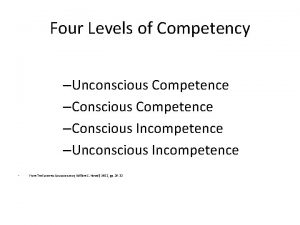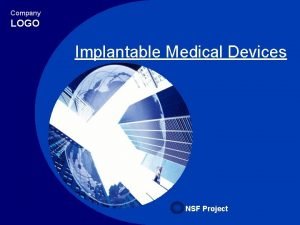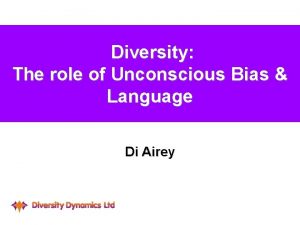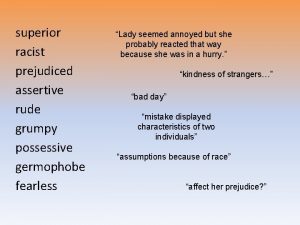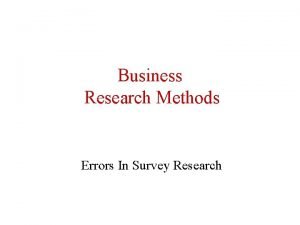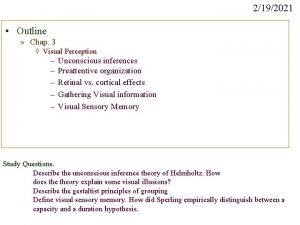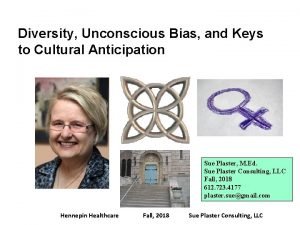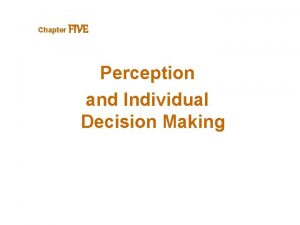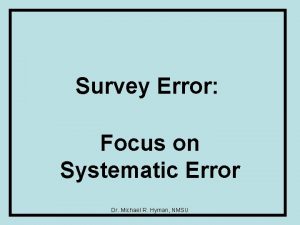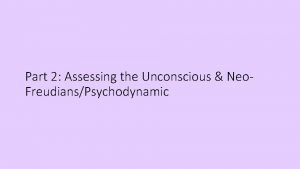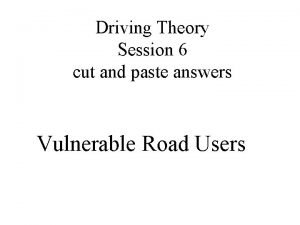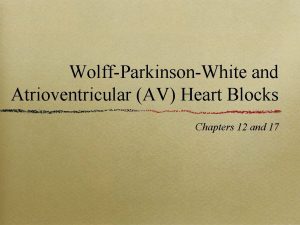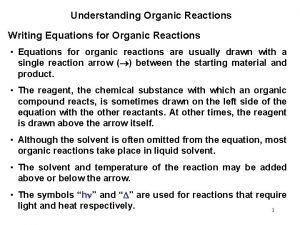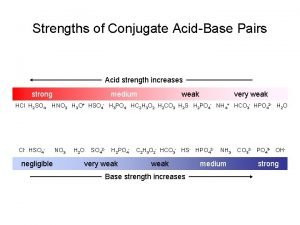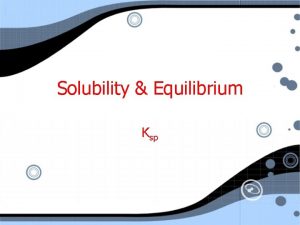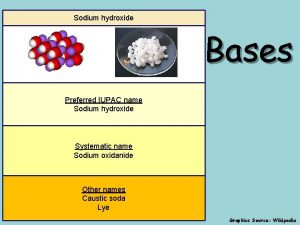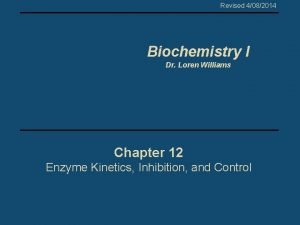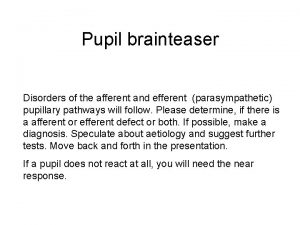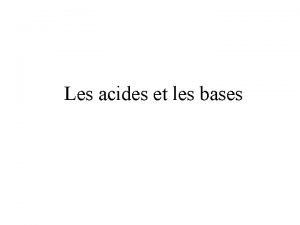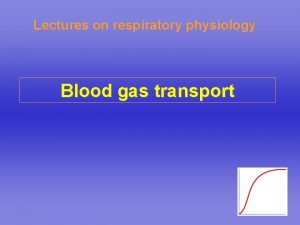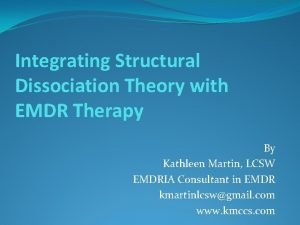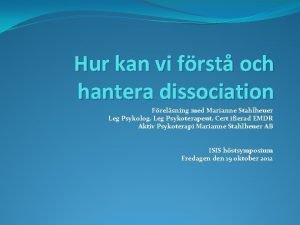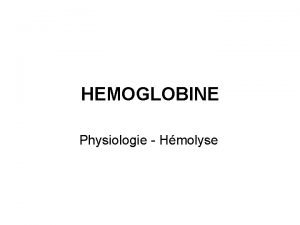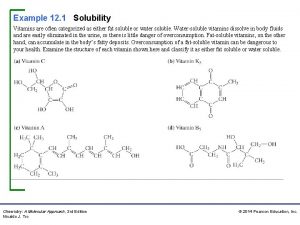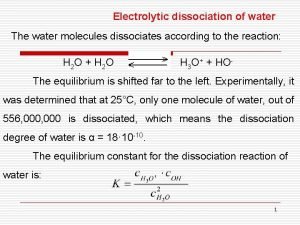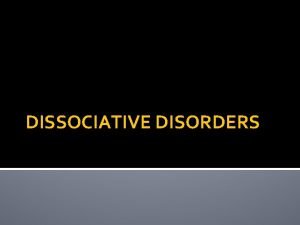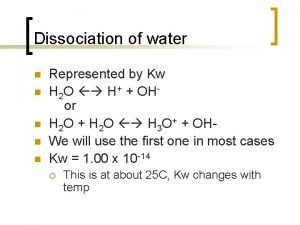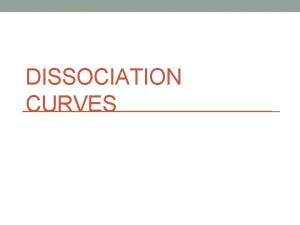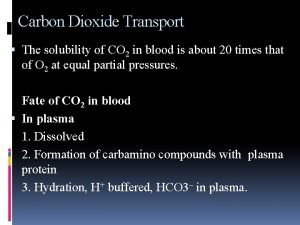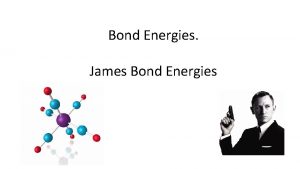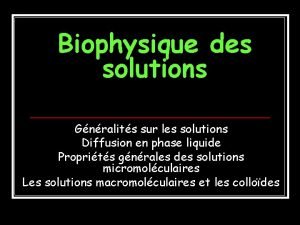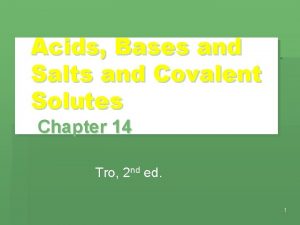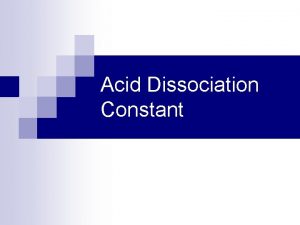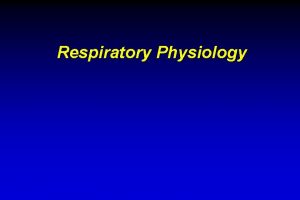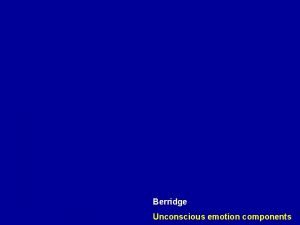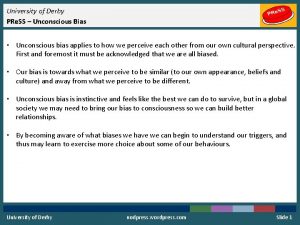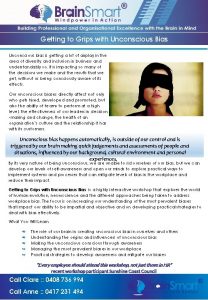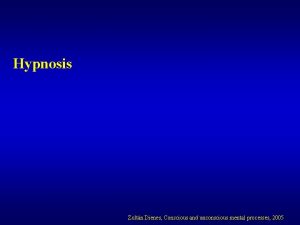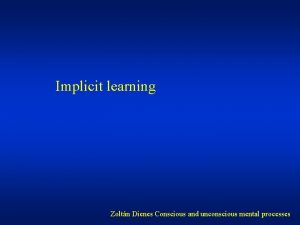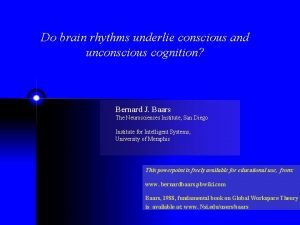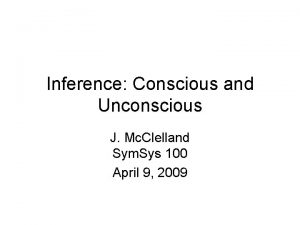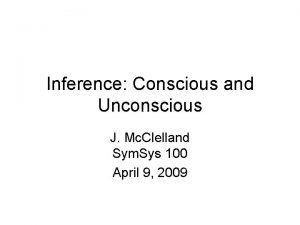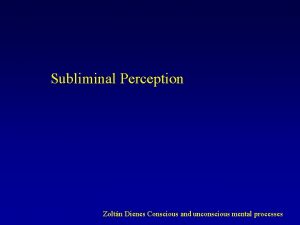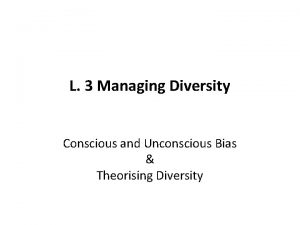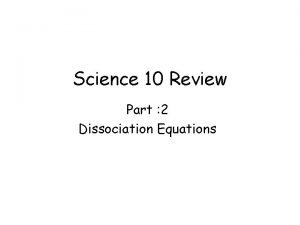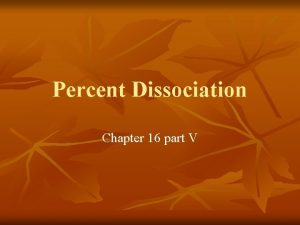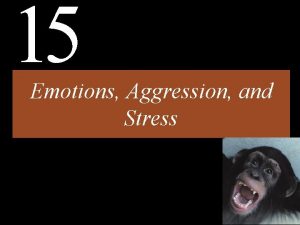Dissociation of neural circuitry for conscious and unconscious



















































- Slides: 51

Dissociation of neural circuitry for conscious and unconscious processing of personally-significant faces. María A. Bobes Center for Neuroscience, Cuba

Assoc. prospag. . Bruce and Young, 1986 Many different types of information derived from faces: race, sex, emotional-expressions, age, identity

Face identity also offers socio-emotional information Emotion-from-identity Faces tell us who is who (e. g. good and bad or friends and enemies) Face identity has emotional content !

Double dissociation between identity recognition and emotional processing of face identity Prosopagnosia Tranel, Damasio & Damasio, JOCN, 1995, 7: 432 Medial orbitofrontal damage

Ca Assoc. prospag. . Modified Bruce & Young model to accommodate double dissociations (Ellis et al) Medial Orbitofrontal p s a r g

Limitations of purely cognitive models • Theories are under-constrained • They have poor contact with neurophysiological data • The posited pathways are not informed by neuroanatomy • Early attempts to make the connections were heavily criticized because they were based on incomplete data & were difficult to test (recommendation then to ignore anatomy)

STS OFA FFA = Hasson, Harel, Levy, & Malach, Neuron, 2003 >

Posterior Superior Temporal Sulcus (p. STS) Core Area of the Face Processing System (Haxby et el, 2000) Extended system for familiar faces?

What is unclear • Are there additional areas involved? f. MRI correlation • What are the connections of these areas DTI. Tractography • What is the functional contribution of each area Lesions causal inferences • How brain damage disrupt this circuitry

f. MRI Event related design · St Duration: 1 s · SOA: variable between 4 and 6 s 3 sessions. Each session: • 15 acquaintance faces, • 15 learned faces, 30 unknown faces • 45 houses. Target (40 %) Standard (60 %) 1. 5 Tesla TR= 2 16 slices Statistical Analysis: SPM 5+ inhouse scripts

f. MRI analysis • ROI localization of areas responding to faces (faces > houses) • Finite impulse response estimations for each stimuli condition in each ROI • Permutation t test over the FIR. (Time characterization)

Activation for faces >houses Regions of Interest ROI • FFA (L/R) • OFA (L/R) • AIT (L/R) Structural face processing Semantic processing • Post. Cing. (L/R) • Medial Orb. fr. (L/R) • Insula • Dorsolateral Frontal (L) • Inferoparietal (L) Emotional processing Attention working memory

OFA d FFA d OFA d Acq vs 0 Unfam vs 0 Acq vs Unfam

OFA d OFM d FFA d Fam vs 0 Desc vs 0 Fam vs Desc

Group analysis Unknown faces > Houses STS OFA FFA acquaintance > unknown faces PC m. OFC AIT

To Summarize • BOLD responses to faces of acquaintances were of larger amplitude and longer duration than to faces of strangers in all ROI, especially in the right hemisphere. • This differential responsiveness increases as one moves from extrastriate areas to PC to lateral and medial prefrontal cortex. • There are striking differences in BOLD timecourses in different ROI and interestingly for different conditions in the same ROI (excludes local vascular factors or regional differences in the coupling of neural activity). • This suggests that different BOLD time-courses could reflect distinct neural patterns of activity.

Attempt to ‘connect’ voxels Basser et al. , 1999 Mori et al. , 1999 on basis of directional similarity of coincident eigenvectors

Classical DTI tractography: tracts defined by ROIs in white matter: -Good “in vivo” reproduction of tracts found by “post-mortem” dissection -Unfortunately relationship with functional areas (e. g. OFA, FFA) not precise -Gets “lost” or stops in GM SLF Catani, Brain, 2005

Probabilistic DTI-tractography seeded with f. MRI data • A Monte Carlo simulation (n=200) is run at each seed voxel and at every step of the path construction a direction randomly drawn from a distribution). • Validity measure calculated for all paths. • Seed ROIs can be placed in GM • Paths can penetrate GM • Here we used clusters of f. MRI activation specific to faces as seeds for the tractography • Average of validity measures for all paths coming from the same ROI and reaching any voxel was used as an index of connectivity between the ROI and the voxel.

Voxelwise, T-test, n=30, of connectivity index, FDR=0. 05 Additive color map Seed ROI defined by f. MRI OFA FFA

SLF? (p. STS) m. Or. F CP Visual retinotopic cortex (v 4) Occipital Face Area (OFA) Fusiform Face Area (FFA) Anterior Inferior Temporal (AIT) l. Or. F? IFL IFOF Modified model of the Face Processing System

Summary of new findings from normal subjects 1. Core areas have larger BOLD responses to familiar faces but ERPs elicited in these areas are not affected by familiarity: Suggests feedback from later activated areas. 2. The extended face processing system for familiar faces includes the posterior cingulate and medial orbitofrontal cortex. 3. DTI-tractography seeded by f. MRI data suggest a massively parallel face processing system, less sequential than posited in original models. 4. V 4, OFA and FFA all feed in parallel into the Inferior longitudinal fasciculus and the Inferior Frontooccipital fasciculus.

• Are all these areas necessary ? • Need for lesion studies

Case F. E. (69 year old male) • Brain injury / bilateral subdural hematomas (trauma). • Neuropsychology: normal except face recognition • Basic face processing relatively intact (Benton, Bruyer and Warrington test batteries). • Dense associative prosopagnosia (zero recognition of famous people or acquaintances), cannot learn new faces Person identification relies on voice, gait, clothing R L Severe bilateral damage to ventral occipito-temporal cortex

Forced choice face selection Unknown Acquaintance (family) Which face is more trustworthy ? Which face is nicer ? 10/14 (71 %) p<0. 028 Implicit 12/14 (86 %) p<0. 008 Implicit 8/14 (57 %) Is more familiar ? ns Overt Bobes et al, COGNITIVE NEUROPSYCHOLOGY, 2004, 21

Skin Conductance Response (SCR) Bobes et al, COGNITIVE NEUROPSYCHOLOGY, 2004 Acquaintances unfamiliar F. E. presented larger skin conductance responses to familiar than to unfamiliar faces.

Voxel-wise Hotelling T 2 test, using vector of intravoxel GM, WM and SCF concentration, contrasting FE vs. 237 control FDR threshold q<0. 01 L R

% Damaged voxels in cortical regions defined by AAL atlas

Patient FE. ER-f. MRI Acquaintances, Unfamiliar faces, Houses • ROI (faces > houses) • Finite impulse response estimations for each stimuli condition in each ROI • Statistical comparison of the patient´s response to that of the sample of normal controls (Crawford et al, 2006)

1 Left Right FFA OFA FFA x=44 OFA y=-78 OFA z=-14

PC m. OFC CA Left Right m. OFC x=0 y=34 z=10

FE: Left m. OFC Controls> FE

Voxel-based tractography (OFA seeds) deficit analysis: voxel-wise ttest, FE vs 30 controls, FDR q=0. 01 Deficits in the territory of the right and left ILF Method limited by large variance of values in some voxels control subjects

Combined DTI/f. MRI: Probabilistic Tracts with group OFA seeds for controls and individual OFA seeds for F. E. IFOF Apparently preserved (more on the left ) Only F. E. Lower branches of IFL leading to AIT cortex Overlap F. E. & controls and MTL are more affected >70 % controls

SLF? (p. STS) m. Or. F CP X Visual retinotopic cortex (v 4) X XX IFL X Occipital Face Area (OFA) Fusiform Face Area (FFA) Anterior Inferior Temporal (AIT) IFOF Residual face processing system in FE l. Or. F?

SLF? (p. STS) m. Or. F CP Visual retinotopic cortex (v 4) X XX Occipital Face Area (OFA) Fusiform Face Area (FFA) Anterior Inferior Temporal (AIT) l. Or. F? IFOF Residual face processing system in FE

SLF? (p. STS) m. Or. F CP Visual retinotopic cortex (v 4) Occipital Face Area (OFA) Fusiform Face Area (FFA) Anterior Inferior Temporal (AIT) IFL IFOF ERPs ? Time course of activation l. Or. F?

Newly-Learned Faces Acquaintance faces Faces of unknown persons artificially learned in the lab Faces of relatives and very close friends Unique identity Identity based on face structural Memory engrams information Affective significance Semantic Information Similar visually familiarity Different emotional value

ERP paradigm · St Duration: 1 s · SOA: 2 s Two blocks : Random presentation of 16 target known faces and 75 standard unknown faces. In one block known faces were acquaintances and in the other, newly-learned faces. Task: To discriminate between familiar (acquaintance or learned) and unfamiliar faces by pressing a key Subjects: 15 normal adults (7 F and 8 M), ages between 21 and 32 120 channels 0. 05 -30 Hz Onset latency 10000

N 170 An index of early structural analysis of faces P 300 An index of the availability of relevant memories for people. P 3 b. (parieto-central) • P 3 a. (frontally distributed)

Learned Faces (LF) in normal subjects. Target LF Standard UF • No difference in N 170 (structural processing) • P 3 b. Conscious processing of familiarity

Acquaintance faces (AF) in normal subjects Target AF Standard UF • No difference in N 170 (structural processing) • P 3 b. Conscious processing of familiarity • Additional P 3 a. Emotional processing of identity

A Newly-learned 500 -580 ms B Acquaitances 460 -570 ms C Acquaitances 300 -380 ms

Current source stimation BMA mode. l Average Brain MNI. A) P 3 b. Newly-learned • Temp-parietal • Polo temp • Frontal inf. • Frontal dorsal B) P 3 b. Acquaitances • Temp-parietal • Polo temp • Frontal inf. • Frontal dorsal C) P 3 a. Acquaitances • OFM • Amigdalas • Polo temporal, • Insula

Summarizing • The effect of familiarity appears after 300 ms once the structural processing (indexed by N 170 has been completed) • Learned faces evoke only the parietal positivity • Acquaintance faces evoke two different components: a large positivity widely distributed and maximal at parietal sites, and an earlier positivity restricted to frontal sites, which is probably generated at OFM and amygdalas.

ERPs. P 300 Bobes et al, COGNITIVE NEUROPSYCHOLOGY, 2004, 21 0 % hits Target AF Standard UF • No difference in N 170 (structural processing) • An early and fronto-central P 3 (P 3 a). Emotional processing of identity • No P 3 b. (Conscious processing of familiarity) • P 3 a adicional: Procesamiento emocional de la identidad

FE. Estimación de fuentes intracraniales. P 3 a o P 3 b? • Metodo. BMA • Volumen. RMN sujeto FE OFM, amigdalas, polo temporal Las fuentes generadoras de P 300 en FE coinciden con las de P 3 a en normales.

ERP • The processing of emotion from identity does not necessarily occur before identity have been consciously detected. • Covert recognition of familiar faces in prosopagnosia evoked the P 3 a component generated in emotional system

Conclusions 1. FFA is not necessary for covert recognition of familiar faces which could be enabled by OFA. Previous work (Rossion et al) has show that FFA activation is not sufficient for familiar face recognition. 2. OFA and med Orbito. Frontal cortex serve as hubs for covert (unconscious) recognition 3. Prosopagnosia not only due to lesion of “core face areas” but also a disconnection syndrome (IFL disruption) that blocks conscious recognition

Conclusions 4. Unconscious recognition could be mediated by the Inferior Occipito-Frontal Fasciculus or by more indirect pathways via the SLF or the Cingulate fasciculus. 5. Multimodal neuroimaging of neuropsychological cases is a powerful constraint for models of cognitive processing. 6. More effort is needed to develop of statistical techniques for multi-modal image comparison of singles cases to normal controls.

Research team Habana, Cuba • Maria A. Bobes • Lorna Garcia • Yasser Iturria • Ileana Quiñones • Yusniel Santos • Lester Melie • Pedro Valdes Hernandez • and many others from CNEURO Medellin, Colombia • Francisco Lopera • Jose Ascencio
 Conscious proprioception
Conscious proprioception 4 levels of competence
4 levels of competence Implant circuitry surge 2
Implant circuitry surge 2 Forgotten core circuitry disassembler
Forgotten core circuitry disassembler Psychodynamic theory of personality
Psychodynamic theory of personality Unconscious bias and language
Unconscious bias and language John william waterhouse circe offering the cup to ulysses
John william waterhouse circe offering the cup to ulysses Unconscious bias questions
Unconscious bias questions Carl jung theory
Carl jung theory Unconscious patronization
Unconscious patronization Topographical model of the mind
Topographical model of the mind Meaning of unconscious mind
Meaning of unconscious mind Carroll izard 10 basic emotions
Carroll izard 10 basic emotions Amber nova unconscious
Amber nova unconscious Conscious proprioception
Conscious proprioception Freud anima
Freud anima Auspices bias
Auspices bias Unconscious inferences
Unconscious inferences Unconscious bias icebreaker
Unconscious bias icebreaker Is an unconscious process created from distilled experience
Is an unconscious process created from distilled experience Auspices bias example
Auspices bias example Neo psychoanalytic theory
Neo psychoanalytic theory You should never attempt to overtake a cyclist
You should never attempt to overtake a cyclist Av dissociation
Av dissociation Bond dissociation energy table
Bond dissociation energy table Ionization equation for hydrochloric acid
Ionization equation for hydrochloric acid Iodate solubility
Iodate solubility Hydroxide catalysis bonding
Hydroxide catalysis bonding Kcat equation mcat
Kcat equation mcat Restoring the shattered self
Restoring the shattered self Isocoric pupil
Isocoric pupil Base forte
Base forte Co2 dissociation curve
Co2 dissociation curve Emdr readiness checklist
Emdr readiness checklist Strukturell dissociation
Strukturell dissociation L'hémolyse physiologique
L'hémolyse physiologique Calcium nitrate dissociation equation
Calcium nitrate dissociation equation Dissociated meaning
Dissociated meaning Dissociative
Dissociative Water dissociation
Water dissociation Haemoglobin
Haemoglobin Co2 dissociation curve
Co2 dissociation curve Dissociation adhd
Dissociation adhd Dissociation constant protein
Dissociation constant protein James bond chemistry
James bond chemistry Po4na3 dissociation
Po4na3 dissociation Dissociation des acides aminés
Dissociation des acides aminés What is degree of dissociation formula
What is degree of dissociation formula Ionization vs dissociation
Ionization vs dissociation Honh2 dissociation equation
Honh2 dissociation equation Binding constant
Binding constant Lugworm oxygen dissociation curve
Lugworm oxygen dissociation curve

